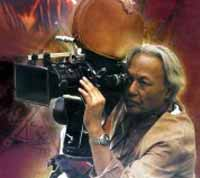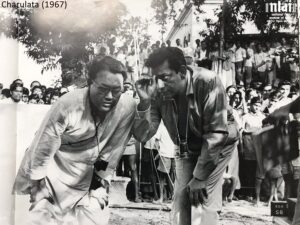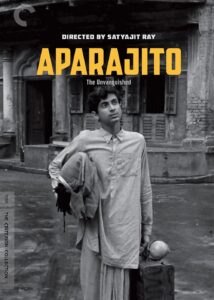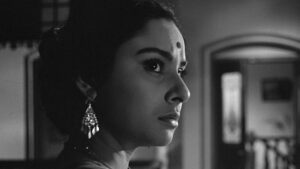
Bounce lighting: Subrata Mitra!
Jun 15 2023
When the films where Black and white and slow speed ASA ( iso), straight Lighting with distinct shadows were the norm all over the world of film making.

Never imagined Bounce lighting techniques was invented by Indian Cinematographer Subrata Mitra.

In his 30-year career, Mitra shot only 17 features. Ten of these were with Satyajit Ray. Standard cinema histories rate these among the best films ever made. His work began with Ray’s debut Pather Panchali in 1955, wound its way through Jalsaghar, Devi, Mahanagar and Charulata, and ended with Nayak in 1966.

In Aparajito (1956), Apu and his indigent family briefly relocate to Varanasi. For a sequence set in Apu’s new home, Mitra used the method known as bounce lighting – a revolutionary approach at the time.
Mitra invented what is now known as bounce lighting.
The fear of monsoon rain had forced the art director, Bansi Chandragupta, to abandon the original plan to build the inner courtyard of a typical Benares house in the open and the set was built inside a studio in Calcutta.
The idea was to create a overcast exterior sky light effect on a indoor set.
Instead of using direct lighting to illuminate the set, Mitra placed a framed white sheet over the set to resemble a patch of sky and arranged the studio lights below this to bounce off the fake sky. The result was a simulation of soft, diffused, shadowless light, reflected from the artificial sky.
Then Ten years later Cinematographer Sven Nykvist used bounced lighting in his films

Some Experts from Legendary Subrata Mitra on his approach towards lighting…
He says main factor is the ‘brightness of the image’.
How to photograph a room where there is no light?
How much do we want to show the
spectator?
The darkness may have various shades. If the cameraman wishes he can make the scene so dark that the spectator hardly see anything; he can only make out that there are two persons in the
room. Possibly the director wants this. He wishes to give prominence
to the dialogue or sound. Or the cameraman may not make the scene very dark because the director wishes to show the face of the heroine.
Incidentally one can say that this deep darkness or lighter darkness
falls in the category of ‘no light’.
Another factor is the ‘quality of light’; it may be a concentrated
beam of light casting hard shadows and modelling everything in high
contrast or a soft diffused shadowless light, casting soft shadows or
no shadows at all, and modelling everything, in a subtler manner. For
instance the sunlight enters that room may be a direct light or just
a diffused soft daylight, or the shaft of light from the next room which softly illuminates the room at night by being reflected from a wall.
What is the language of light?,’Mitra compared it to music.’ ‘How can a director and a cameraman really speak to one another?’ Subrata proposed that the scale of seven notes correspond to seven shades of gray or seven scales of contrast.
Subrata Mitra filmography
1955 : Pather Panchali – Directed: Satyajit Ray
1956: Aparajito – Directed: Satyajit Ray
1957: Parash Pathar – Directed: Satyajit Ray
1958: Jalsaghar – Directed: Satyajit Ray
1959: Apur Sansar – Directed: Satyajit Ray
1960: Devi – Directed: Satyajit Ray
1962: Kanchenjungha – Directed: Satyajit Ray
1963: The Householder – Directed: James Ivory
1963: Mahanagar – Directed: Satyajit Ray
1964: Charulata – Directed: Satyajit Ray
1965: Shakespeare Wallah – Directed: James Ivory
1966: Nayak – Directed: Satyajit Ray
1966: Teesri Kasam – Directed: Basu Bhattacharya
1969: The Arch – Directed: Tang Shu Shuen
1969: The Guru – Directed: James Ivory
1970: Bombay Talkie – Directed: James Ivory
1974: Mahatma and the Mad Boy – Directed: Ismail Merchant
1985: New Delhi Times – Directed: Ramesh Sharma
Article edited by
CJ Rajkumar
Author/ Cinematographer
